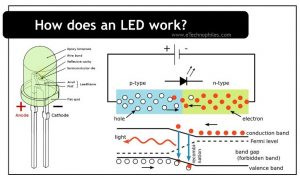Last updated on March 28th, 2024 at 12:33 pm
A light-emitting diode (LED) is a semiconductor device that emits visible light when an electric current is passed through it. It is used in various applications, including indicator lights on electronic devices, traffic signals, and illuminated signs. In this article, we will discuss its working, characteristics, and applications.
Table of Contents
Symbol
The symbol is shown in the figure below. Two arrows (projecting outward) represent the emission of light. LED has similar electrical characteristics to a PN junction diode. It allows current to pass during forward biasing and blocks current in reverse bias.

Note: The leg of the anode is longer than the cathode.
How does an LED emit the light?
It emits light when current flows through it. The figure below shows a simple circuit in which an LED is connected to a battery with a resistor. When the switch turns on, the LED conducts current and starts glowing. Let us understand the process in detail.
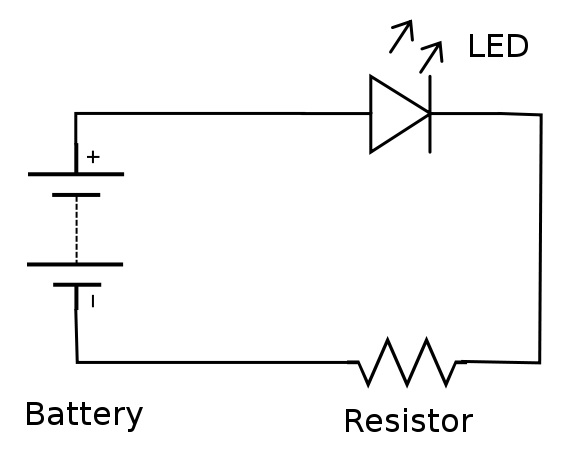
When electrons recombine with holes within the semiconductor material, they release energy in the form of photons. The emitted photons are then funneled out through a lens, which focuses the light into a beam.
When the diode is forward biased, minority charge carriers(electrons) move from p-type material to n-type material. Similarly, minority charge carriers(holes) move from n-type material to p-type material. At the junction, the extra minority carriers recombine with the majority charge carriers. Thus energy is emitted in the form of photons.
In ordinary diodes, energy is released in the form of heat during recombination. But in LEDs energy is emitted in the form of photons.
Why a series resistance is required in this circuit?
An LED might get damaged when a forward voltage is directly applied to it. It will draw all the permitted current from the supply and may get damaged. To limit the current, a series resistance is connected.
How much current does an LED draw?
It typically draws current in the range of 10-30mA. The current flow determines its brightness. The higher the current, the brighter will be the LED. However, too much current can damage it, so it is important to find the right balance.
What is Electroluminescence?
Electroluminescence is the phenomenon of a material emitting light in response to an electric current. When an electric field is applied to these materials, it causes electrons to flow from the positive electrode to the negative electrode.
As these electrons move through the material, they collide with atoms and release photons (light particles). The frequency of these photons determines the color of the light that is emitted.
How different colours are produced by LEDs?
The color of the light emitted by an LED depends on the material used to create the semiconductor. For example, red LEDs are made from gallium arsenide, while blue and green ones are made from indium gallium nitride.
By changing the material used to create the semiconductor, manufacturers can produce LEDs that emit a wide range of colors. The table given below shows the emitted light colors and their corresponding wavelength, voltage drop, and materials used for manufacturing them.
| Colour | Wavelength (nm) | Voltage Drop (V) | Semiconductor Material |
| Infrared | > 760 | < 1.9 | Gallium Arsenide, Aluminium Gallium Arsenide |
| Red | 610 – 760 | 1.6-2.0 | Aluminium Gallium Arsenide, Gallium Arsenide Phosphide, Aluminium Gallium Indium Phosphide, Gallium Phosphide |
| Orange | 590 – 610 | 2.0-2.1 | Gallium Arsenide Phosphide, Aluminium Gallium Indium Phosphide, Gallium Phosphide |
| Yellow | 570 – 590 | 2.1-2.2 | Gallium Arsenide Phosphide, Aluminium Gallium Indium Phosphide, Gallium Phosphide |
| Green | 500 – 570 | 1.9-4.0 | Gallium Indium Phosphide, Aluminium Gallium Indium Phosphide, Aluminium Gallium Phosphide, Indium Gallium Nitride |
| Blue | 450 – 500 | 2.5-3.7 | Zinc Selenide, Indium Gallium Nitride, Silicon Carbide, Silicon |
| Violet | 400 – 450 | 2.8-4.0 | Indium gallium Nitride |
| Purple | multiple types | 2.4-3.7 | Dual Blue/Red LEDs, Blue with Red Phosphor, White with Purple Plastic |
| Ultraviolet | < 400 | 3.1-4.4 | Diamond, Boron Nitride, Aluminum Nitride, Aluminium Gallium Nitride, Aluminum gallium Indium Nitride |
| Pink | multiple types | 3.3 | Blue with phosphor, Yellow with Red, Orange, or Pink phosphor, White with Pink pigment |
| White | Broad spectrum | 3.5 | Blue/UV diode with Yellow Phosphor |
Types of LED
Different types of LEDs are manufactured using semiconductors. Let’s look at them.
RGB LEDs
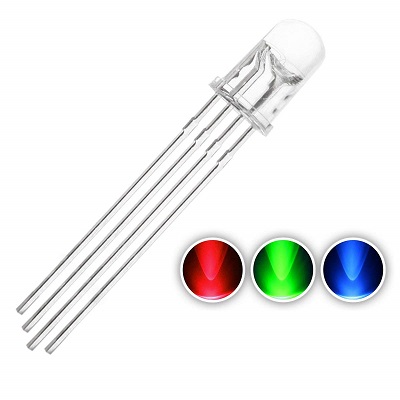
RGB stands for Red, Green, and Blue. We know these are primary colors and their combination can produce different colors. By controlling the intensity of each light we can produce various colors.
It has 4 legs. One common pin acts as an anode and the other three are for illuminating three colors.
Addressable
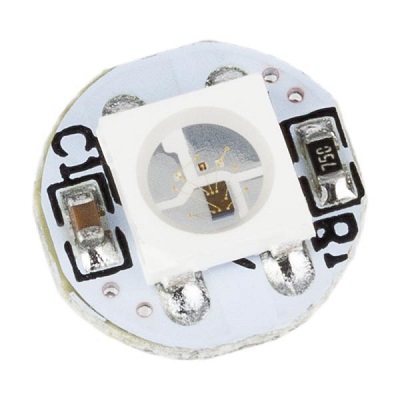
These can be controlled using a chipset. WS2812, APA102, UCS1903, etc are some of the chipsets.
Built-in Resistor LEDs
These have a chip to control limiting currents.
High-Power
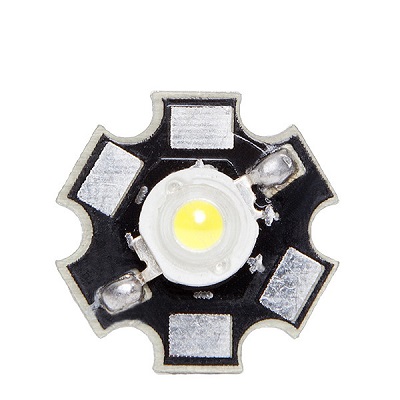
They are superpower LEDs. They dissipate 1 watt (or more) of power. They generate heat and might damage if no proper cooling method is used with them. So a heat sink must be attached to them.
Bi and Tri-Colour
It will contain two or three colors encapsulated in the same case to produce a variety of colors. It has two or three terminals.
Alphanumeric
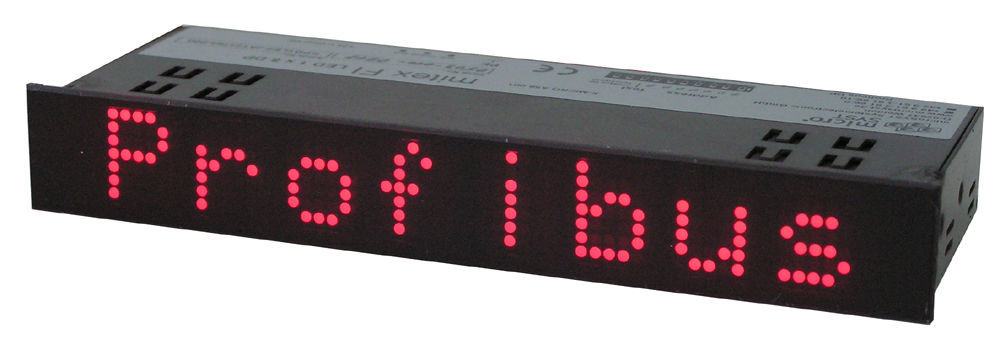
They are used to display characters and numerals.
Lighting
They are used for decorations, interiors, walls, etc.
Advantages
- Low power consumption
- Long life (35,000 to 50,000 hours of useful life)
- Low operating voltage
- Available in a wide range of colors
- Compact size and can easily attach to circuits
- Monochromatic light output
Single-wavelength light sources are known as monochromatic lights, where mono stands for only one and chroma for color.
Disadvantages
- Voltage sensitivity
- Depends on temperature
Applications
- Illumination lights for decorations and interiors
- As indicator lights in circuits
- Barcode scanners use red LEDs instead of LASERS
- Ultraviolet LEDs for sterilization (spectra range of 220 nm to 395 nm)
- As a light source in visible light communication
- Street lights, Lighting in cars, motor vehicles, etc
- Used in displays
- LED lighting products light up to 90% more efficiently than incandescent light bulbs.
